A median in a triangle is a line segment that extends from a vertex to the midpoint of the opposite side, dividing it into two equal parts.
Height in a triangle
Height in a triangle
Additional properties:
- In every triangle, it is possible to draw 3 medians.
- All 3 medians intersect at one point.
- The median to a side in a triangle creates 2 triangles of equal area.
- In an equilateral triangle - the median is also a height and an angle bisector.
- In an isosceles triangle - the median from the vertex angle is also a height and an angle bisector.
- In a right triangle - the median to the hypotenuse equals half the hypotenuse.
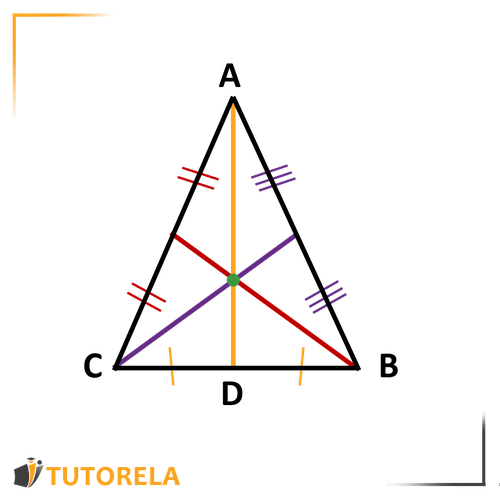
Test yourself on parts of a triangle!

Is DE side in one of the triangles?
Height in a triangle
In this article, we will learn everything you need to know about medians in a triangle! Don't worry, the material about medians in a triangle is both easy and straightforward to understand.
Define a median in a triangle?
A median in a triangle is a line segment that extends from a vertex to the midpoint of the opposite side, dividing it into two equal parts.
Remember that "median" in real life represents the middle point, and similarly here it divides the side in the middle!
We can observe this in the following drawing:
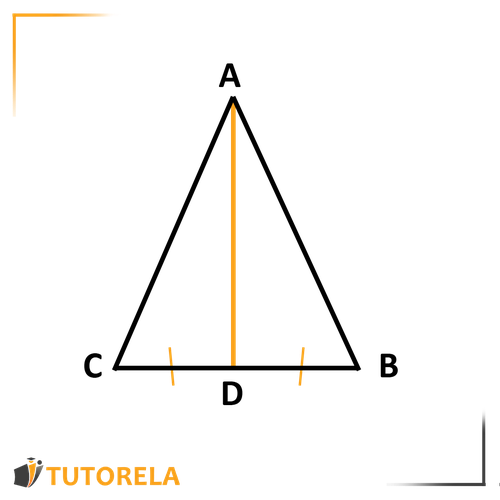
In triangle
is a median - it extends from the vertex and divides the opposite side into two
equal parts:
Additional Properties of a Median in a Triangle:
- In every triangle, it is possible to draw 3 medians.
- All 3 medians intersect at one point.
- The median to a side of a triangle creates 2 triangles of equal area.
You can observe this below:

Since there are 3 vertices in a triangle, there can be 3 medians.
Each median extends from a vertex to the opposite side and bisects it.
All medians intersect at one point.
Reminder:
How do we calculate the area of a triangle?
If we take for example the triangle and want to calculate its area when:
height =
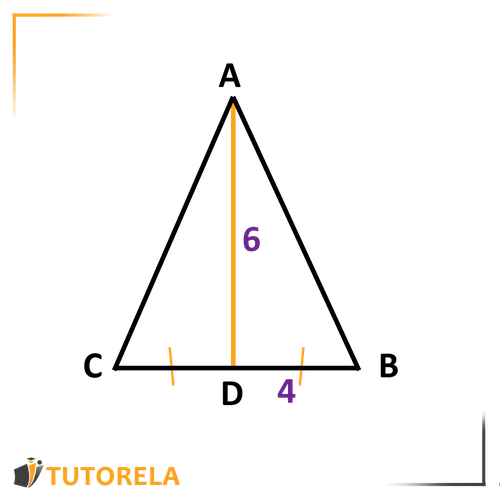
We can deduce that the area of triangle is:
Now if we draw the median we can observe that the two triangles it creates are equal in area.
The side is divided in the middle thus it is identical in both triangles and the height is identical.
Therefore, the area of each created triangle is identical and will be equal to half the area of triangle
The triangle ABC is shown below.
To which side(s) are the median and the altitude drawn?
Look at triangle ABC below.
What is the median of the triangle and to which side is it drawn?
Look at triangle ABC below.
Which is the median?
3 important statements about medians:
- In an equilateral triangle - the median is also a height and an angle bisector.
As shown in the figure:
is a height to side
and also a median to side (divides it into two equal parts)
as well as an angle bisector
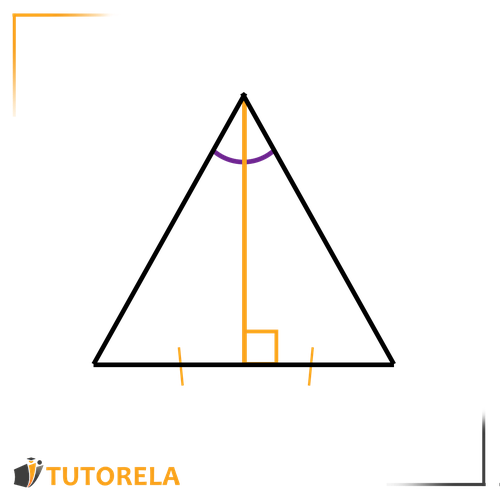
- In an isosceles triangle - the median drawn from the vertex angle is also a height and an angle bisector.
Let's observe this in the figure below:
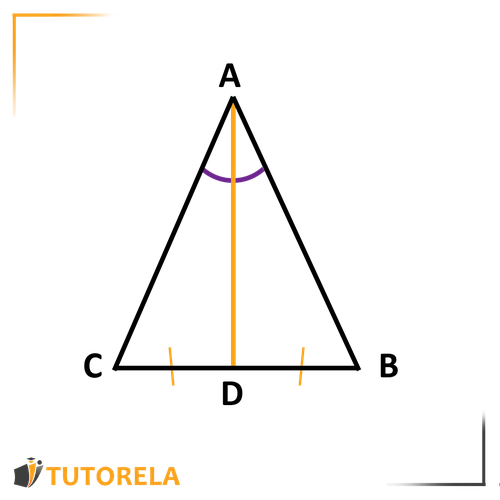
is a median drawn from vertex angle .
It is also a height to side , as well as a median to , in addition to bisecting the vertex angle .
3. In a right triangle - the median to the hypotenuse equals half the hypotenuse.
We can observe this in the figure below:
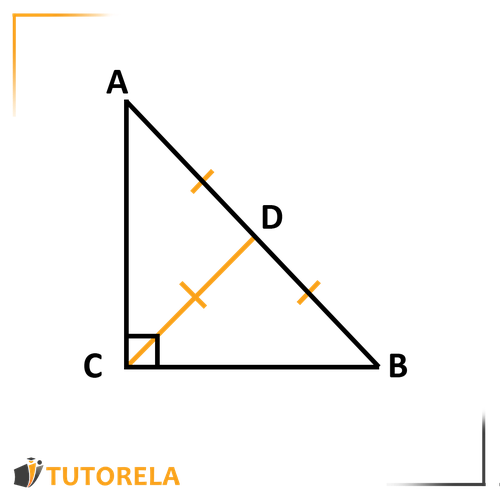
Triangle is a right triangle.
is the median to the hypotenuse and equals half of the hypotenuse.
That is
Exercise:
Given:
is a median in triangle
is a median in triangle
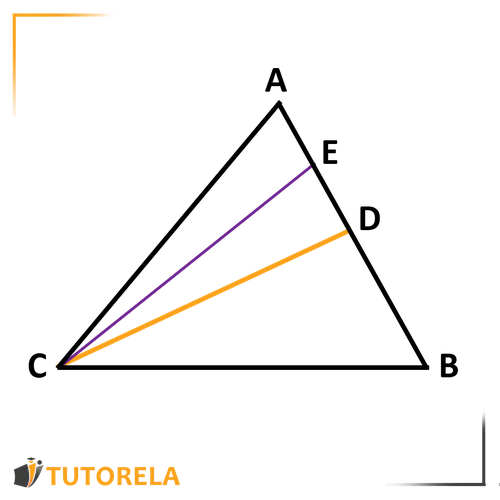
- Calculate the length of segment .
- Determine the area of triangle if it is known that the area of triangle is ?
- Based on your answer in part b, determine the area of triangle
Solution:
- Let's mark the given information in the drawing.
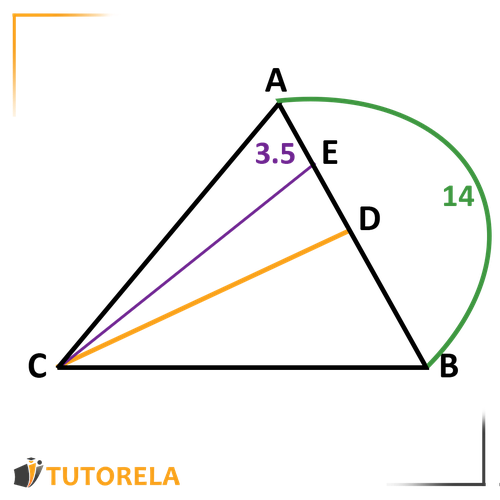
Given that –
Since is a median,
due to the fact that the median bisects the side at its midpoint.
Given that is also a median.
Therefore .
2. Given that the area of triangle is
The area of triangle
must also be . A median divides the triangle into two triangles of equal area.
3. The area of triangle must be equal to the area of triangle .
Triangle consists of two triangles with equal areas that sum up to .
Therefore, the area of triangle is .
Look at the triangle ABC below.
\( AD=\frac{1}{2}AB \)
\( BE=\frac{1}{2}EC \)
What is the median in the triangle?
ABC is a triangle.
What is the median of the triangle?
Look at the triangles in the figure.
Which line is the median of triangle ABC?
Examples with solutions for Parts of a Triangle
Exercise #1
Given the following triangle:
Write down the height of the triangle ABC.
Video Solution
Step-by-Step Solution
An altitude in a triangle is the segment that connects the vertex and the opposite side, in such a way that the segment forms a 90-degree angle with the side.
If we look at the image it is clear that the above theorem is true for the line AE. AE not only connects the A vertex with the opposite side. It also crosses BC forming a 90-degree angle. Undoubtedly making AE the altitude.
Answer
AE
Exercise #2
Which of the following is the height in triangle ABC?
Video Solution
Step-by-Step Solution
Let's remember the definition of height of a triangle:
A height is a straight line that descends from the vertex of a triangle and forms a 90-degree angle with the opposite side.
The sides that form a 90-degree angle are sides AB and BC. Therefore, the height is AB.
Answer
AB
Exercise #3
ABC is an isosceles triangle.
AD is the median.
What is the size of angle ?
Video Solution
Step-by-Step Solution
In an isosceles triangle, the median to the base is also the height to the base.
That is, side AD forms a 90° angle with side BC.
That is, two right triangles are created.
Therefore, angle ADC is equal to 90 degrees.
Answer
90
Exercise #4
Look at the two triangles below. Is EC a side of one of the triangles?
Video Solution
Step-by-Step Solution
Every triangle has 3 sides. First let's go over the triangle on the left side:
Its sides are: AB, BC, and CA.
This means that in this triangle, side EC does not exist.
Let's then look at the triangle on the right side:
Its sides are: ED, EF, and FD.
This means that in this triangle, side EC also does not exist.
Therefore, EC is not a side in either of the triangles.
Answer
No
Exercise #5
Can a triangle have two right angles?
Video Solution
Step-by-Step Solution
The sum of angles in a triangle is 180 degrees. Since two angles of 90 degrees equal 180, a triangle can never have two right angles.
Answer
No
More Questions
Parts of a Triangle
- Finding Angle ADC in an Isosceles Triangle with Given Median
- Calculate Trapezoid Area: Isosceles Triangle with Height 8 and Base 17
- Calculate Trapezoid Perimeter: Inside an Isosceles Triangle with Height 8
- Calculate the Height of Triangle ABC: Perpendicular Distance Problem
- Triangle ABC: Identifying the Correct Height Line
- Area
- Trapezoids
- Area of a trapezoid
- Perimeter of a trapezoid
- Parallelogram
- The area of a parallelogram: what is it and how is it calculated?
- Perimeter of a Parallelogram
- Kite
- Area of a Deltoid (Kite)
- Congruent Triangles
- Angles In Parallel Lines
- Alternate angles
- Corresponding angles
- Collateral angles
- Vertically Opposite Angles
- Adjacent angles
- The Pythagorean Theorem
- Elements of the circumference
- Circle
- Diameter
- Pi
- Area of a circle
- The Circumference of a Circle
- The Center of a Circle
- Radius
- How is the radius calculated using its circumference?
- Rectangle
- Calculating the Area of a Rectangle
- The perimeter of the rectangle
- Congruent Rectangles
- Similarity of Triangles and Polygons
- Triangle similarity criteria
- Midsegment
- Midsegment of a triangle
- Exterior angles of a triangle
- Relationships Between Angles and Sides of the Triangle
- Relations Between The Sides of a Triangle
- Rhombus, kite, or diamond?
- The Area of a Rhombus
- Perimeter
- Triangle
- Types of Triangles
- Obtuse Triangle
- Equilateral triangle
- Identification of an Isosceles Triangle
- Scalene triangle
- Acute triangle
- Isosceles triangle
- The Area of a Triangle
- Area of a right triangle
- Area of Isosceles Triangles
- Area of a Scalene Triangle
- Area of Equilateral Triangles
- Perimeter of a triangle
- Right Triangular Prism
- Bases of the Right Triangular Prism
- The lateral faces of the prism
- Lateral Edges of a Prism
- Height of a Prism
- The volume of the prism
- Surface area of triangular prisms
- Areas of Polygons for 7th Grade
- Right Triangle
- Area of a right-angled trapezoid
- Area of an isosceles trapezoid
- Corresponding exterior angles
- Alternate interior angles
- How do we calculate the area of complex shapes?
- How to calculate the area of a triangle using trigonometry?
- How do we calculate the perimeter of polygons?
- Parts of a Circle









